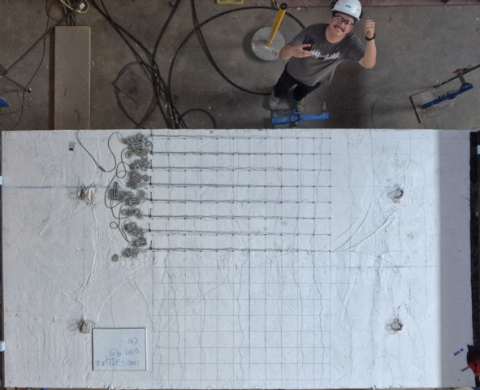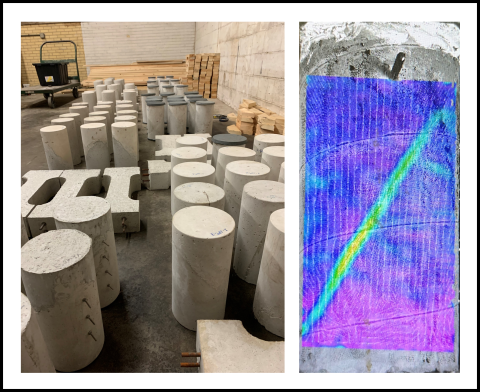

Dagoberto Garza, a Graduate Research Assistant, recently presented his thesis titled, "The Use of High-Strength Reinforcement in Bridge Decks." This thesis investigates the performance of high-strength reinforcement in cast-in-place (CIP) bridge decks with precast, prestressed concrete panels (PCPs) as stay-in-place formwork. A total of six deck strip specimens that simulate transverse and longitudinal section details in CIP- PCP bridge decks were constructed and tested to failure under four-point bending. The test variables include reinforcement grade and spacing of reinforcement in the CIP layer. The experimental tests revealed that high-strength reinforcement had a similar crack-control performance as the conventional reinforcement at the same spacing. Increasing the spacing of reinforcement was found to have negative effects on crack-control performance. All specimens with high-strength reinforcement showed increased flexural capacity compared to the specimens with conventional reinforcement. The findings from this experimental program served as the foundation for formulating recommendations regarding the utilization of high-strength reinforcement in CIP-PCP bridge decks. His research was performed under the supervision of Dr. Oguzhan Bayrak.

Andrea Campos Sanchez, a Graduate Research Assistant also presented her thesis titled, "Investigating Interface Shear Resistance through Slant Shear Tests." This thesis presents the results of a study investigating interface shear resistance through slant shear tests. A total of 54 small-scale and 4 large-scale slant shear specimens were designed across six intrinsic variables: interface angle, interface roughness, concrete strength, casting age difference, aggregate size, and minimum amount of interface shear reinforcement. The slant shear specimens were tested to failure under a uniaxial load, monotonically increasing at a displacement-controlled rate. Based on the test results, interface roughness, aggregate size, and casting age difference were the most influential parameters affecting the interface shear resistance. Additionally, a comprehensive comparison of the interface shear resistance models in five design codes was performed, including AASHTO LRFD, ACI 318-19, CSA A23.3:19, fib MC2010, and Eurocode 2. A modified approach is proposed to calculate the cohesion and friction factors based on intermediary levels of roughness to improve interface shear resistance estimations in current design codes. Ultimately, the research presented in this thesis serves as the initial step in investigating the strength of struts crossing cold joints. Her research was performed under the supervision of Dr. Anca Ferche and Dr. Oguzhan Bayrak.

